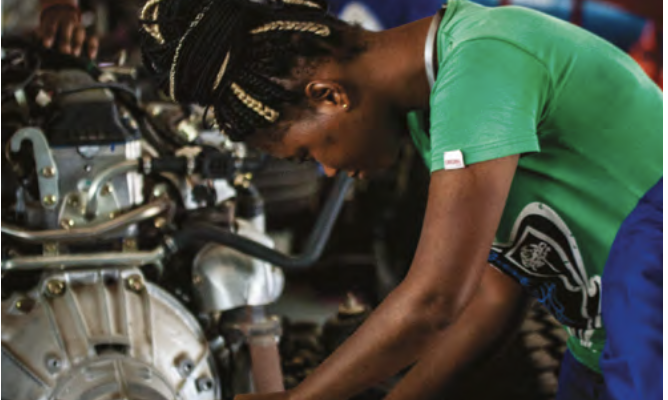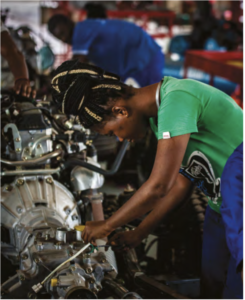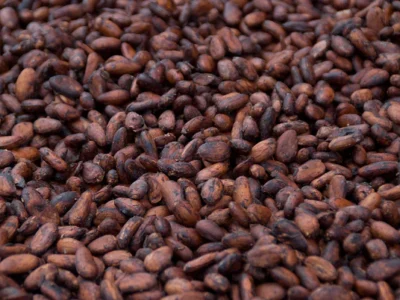Ghana’s manufacturing sector plays a crucial role in the nation’s economic development, contributing significantly to GDP and employment. The
manufacturing industry spans a diverse range of subsectors including agro-processing; textiles and footwear; electronics and household appliances; cocoa processing; and engineering and machine tools. The sector has witnessed steady growth, driven by favourable government policies, increased foreign direct investment, and a commitment to industrialisation under the Ghana Industrial Policy and other strategic frameworks.
The government’s efforts to create a con- ducive business environment have been instrumental in attracting both local and international investors. Initiatives such as the One District One Factory (1D1F) programme aim to decentralise industrial development and promote equitable economic growth across the country. Additionally, the establishment of special economic zones and indus- trial parks, along with incentives like tax holidays and duty exemptions, further enhances the sector’s attractiveness. Ongoing reforms and investments in infrastructure, energy, and technology are expected to pave the way for a more robust and competitive manufacturing landscape.
Ghana’s agro-processing sector has shown significant growth and devel- opment across various commodities. Paddy rice production, for instance, increased from approximately 688,000 tonnes in 2016 to around 973,000 tonnes in 2020, with a consistent con- version rate of 67 percent from paddy to milled rice. Despite this growth, do- mestic milled rice production still falls short of consumption, which rose from 1.2 million metric tonnes in 2016 to 1.6 million metric tonnes in 2020, leading to a persistent trade deficit filled by im- ports. In 2020, Ghana exported about US$220,000 worth of rice while im- porting around US$391 million, resulting in a trade deficit of approximately US$390.8 million.
In the poultry sector, Ghana produced approximately 72,138 tonnes of chicken meat in 2020, with production grow- ing at a compounded annual growth rate of around 6 percent from 2016 to 2020. However, domestic consumption vastly outpaces production, estimated at 400,000 tonnes, driven by a grow- ing middle class and the reopening of the hospitality sector post-Covid-19. In 2020, Ghana was the 24th-largest importer of poultry meat, with poultry being the sixth most imported prod- uct. Chicken remains the most popular source of animal protein, highlighting the demand for increased local produc- tion.
Cassava production in Ghana is also notable, with the country producing ap- proximately 22 million tonnes in 2020, making it the second-largest producer in Africa and the fourth-largest glob- ally. About 1 million hectares of land are dedicated to cassava cultivation, in- volving around 70 percent of Ghanaian farmers. Cassava products, including starch, flour, chips, and ethanol, are ex- ported, although there is a trade deficit in cassava starch. Conversely, trade in cassava flour recorded a surplus of about USD 1.18 million in 2020, indi- cating the potential for increased foreign exchange through exports. The sector’s substantial yield suggests significant op- portunities for further development and export expansion.
Ghana’s sugar production has been minimal since the collapse of the Asu- tsuare and Komenda sugar factories in the 1980s. The government is revitalis- ing the Komenda Sugar Factory and seeking private sector management to operationalise it. In the interim, local companies like OXY Industries Limited have partially met domestic demand and export needs. Despite these efforts, local sugar production is insufficient, necessitating substantial imports to meet both consumption and the needs of various industries. The One District One Factory (1D1F) initiative has also spurred growth in tomato processing, with new factories like Leefound Food Stuff (Ghana) Limited and Weddi Af- rica Limited contributing significantly to local production, aiming to reduce reliance on imports.
The country’s favourable climatic condi- tions provide an ideal environment for cocoa tree cultivation and between 1911 and 1975, it contributed approximately 35 percent of global output during its peak. The Ghana Cocoa Board, estab- lished in 1947, is the primary govern- ment agency responsible for cocoa industry development. To enhance foreign exchange earnings from cocoa exports, the government established the Cocoa Processing Company (CPC) to process cocoa beans into finished prod- ucts such as cocoa liquor, cocoa butter, chocolate, and cocoa powder.
Currently, CPC operates three facto- ries, including two cocoa processing facilities and a confectionary processing plant. Since the economic reforms of the 1980s, the private sector has been active in processing and in 2020, Ghana gener- ated a total export value of US$ 2.1 bil- lion from cocoa beans, cocoa shells, co- coa paste, cocoa butter, and chocolates, with 60 percent of revenue derived from the export of unprocessed cocoa beans.
The textiles and footwear manufactur- ing sector in Ghana comprises ginneries and textile mills that produce a variety of products including batik, wax cloth, and fancy printed cloth. Notably, Ghana boasts traditional textiles such as Kente and Smock. Despite this rich heritage, the country consistently faces trade deficits in the textile trade. The footwear industry is also part of this sector, en- compassing leather, rubber, and textile footwear.
In 2020, textiles and rubber footwear ranked as the sixth to ninth most im- ported products in Ghana respectively, indicating a significant reliance on imports in these categories. Numer- ous foreign retailers operate in Ghana, selling imported textiles and footwear products. Although the textiles industry is largely dominated by foreign players, the domestic market is experiencing rapid growth, presenting opportunities for local manufacturers to expand their presence and meet growing demand.
The country currently faces a shortage of local manufacturers in the house- holds and appliances subsector. De- spite this, household expenditure on electronics and household appliances is projected to exhibit consistent growth across various categories such as PCs, mobile handsets, and audiovisuals from 2022 to 2025.
Similarly, the engineering and machine tools industry faces a notable scarcity of significant players. Instead, the sec- tor is characterised by the presence of artisans, renowned for the trade of auto tools and parts. Distributors of imported machinery and machinery tools largely dominate the market. Moreover, many auto companies have established dealer- ships in the country to supply imported vehicle parts, further contributing to the dominance of imported products in the industry.
In response to this deficit in domestic manufacturing, the government has taken action by initiating the construc- tion of a modern machinery foundry and tooling centre in Accra. This move aims to address the gap in local produc- tion capabilities and foster the growth of indigenous players in the engineering and machine tools industry.
SECTOR OPPORTUNITIES
• Establishment of two or three new refineries, each with a combined capac- ity of approximately 2 million metric tonnes of alumina (refined bauxite).
• Retrofitting of Volta Aluminum Company Limited to increase produc- tion capacity to 300,000 metric tonnes of aluminium.
• Setting up a new smelter with a pro- duction capacity of up to 500,000 metric tonnes of aluminium.
• The government’s Agenda 111 poli- cy presents a significant opportunity for companies in the construction materials sector.
• The Cocoa Roads Improvement Programme (CRIP) offers a chance for players in the construction materials in- dustry to supply road builders.
• Initiatives such as the establishment of one factory in every district and one industrial park in each region, among others, further present opportunities for players in the construction materi- als sector.
• The cashew and cassava sectors present a significant opportunity for investors with capital to invest, as there is ample availability of inputs and the government has introduced a variety of incentives aimed at ensuring the productive and profitable operations of factories.
INVESTMENT INCENTIVES
• Investors can benefit from tax holidays, depending on the incentive scheme an entity registers under, such as free trade zones, the One District One Factory (1D1F) initiative, and the Ghana Investment Promotion Centre (GIPC) itself.
• Ghana offers access to the market of the Economic Community of West Af- rican States ( ECOWAS); the 1.3 billion potential customers across the African Continental Free Trade Area; and Euro- pean Union and United States markets through active trade agreements.
• Compared to other African coun- tries, Ghana boasts relatively stable sup- ply and affordable power costs.
• Compared to other advanced econ- omies, Ghana offers highly attractive low labour costs, making it an appealing destination for establishing production facilities.
• Ghana has abundant agricultural produce, including cocoa, maize, cas- sava, and more, which can support agro- processing industries.
• Ghana benefits from excellent sea and air connections, facilitating the import and export of products to and from international markets, including Europe, America, and Asia.















Comments